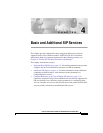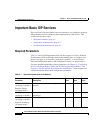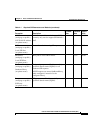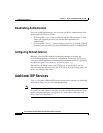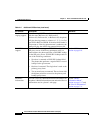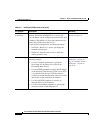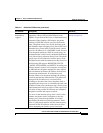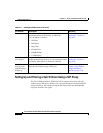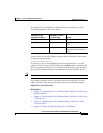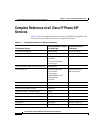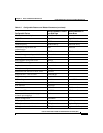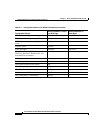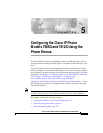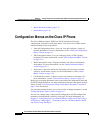
4-9
Cisco IP Phone Models 7905G and 7912G Administrator Guide (SIP)
OL-4277-01
Chapter 4 Basic and Additional SIP Services
Additional SIP Services
Proxy
Redundancy
support
The Cisco IP phone supports next hop server
redundancy when a fully qualified domain name
(FQDN) is specified for the Proxy or Outbound Proxy
parameter. When sending a SIP request, the phone
performs a DNS SRV records query for the domain
name. The phone selects two records from the result
and identifies them as Primary Proxy Farm (PPF) and
Alternate Proxy Farm (APF). Each farm may contain
up to five IP addresses. If a DNS SRV record does not
exist, the phone performs a DNS A records query for
the domain name, which is now considered the Primary
Proxy Farm with no Alternate Proxy Farm. The phone
accepts up to five IP addresses from the query result.
The phone retries with the alternate next hop server for
the following SIP requests: REGISTER, INVITE,
CANCEL, BYE, REFER, and NOTIFY. If sending one
of these requests results in a 5xx response, no response,
or ARP timeout, the phone attempts the same request
with an alternate destination IP address derived from
the next hop domain name. If both primary and
alternate farms exist, the phone attempts the primary
farm first and then the alternate farm. The phone will
attempt all the IP addresses in one farm before
switching to the other farm. Once the phone finds a
responding next hop server, it remembers the farm and
IP address of the server and keeps using it for the given
domain name until it fails or expires. If the request still
fails after all the possible IP addresses are attempted,
the phone considers the request as failed.
If a server in the alternate proxy farm is active at the
moment, the phone can be configured to retry the
primary proxy farm after the number of seconds
specified by the AltProxyTimeout parameter. If this
value is 0, the phone remains with the alternate proxy
farm until all the IP addresses in the farm are down
before attempting the primary proxy farm again.
See the “SIP Parameters”
section on page 8-9.
Table 4-2 Additional SIP Services (continued)
SIP Service Description Reference



